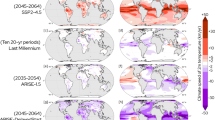Abstract
THE large amount of dust thrown into the atmosphere by volcanoes has long been recognised as an important factor in initiating climatic change that generally leads to cooler surface temperatures1–4. Another source of atmospheric dust is man's agricultural and industrial activity. It has been suggested that this anthropogenic source is a cause of cooling in a manner similar to that of volcanoes5,6. The primary mechanism thought to be responsible for cooling in both these situations is the backscatter to space of a portion of the incoming solar radiation. This reduction in heat input to the planet would cool its surface. Idso7–10 has argued for another effect of atmospheric dust—warming due to ‘thermal blanketing’. This mechanism would absorb some of the Earth's thermal radiation that would otherwise escape to space and then reradiate a portion of this radiation back to the surface, hence a rise in surface temperature with increasing atmospheric dust would be expected. We have completed an experiment recently in which the relative magnitudes of the solar and thermal radiation interactions with atmospheric dust were compared11. The results reported there indicate that there is a general climatological superiority for the thermal radiation interaction, predicting a net warming trend with increasing atmospheric dust for all but the most extreme cases of dust-loading of the atmosphere.
This is a preview of subscription content, access via your institution
Access options
Subscribe to this journal
Receive 51 print issues and online access
$199.00 per year
only $3.90 per issue
Buy this article
- Purchase on Springer Link
- Instant access to full article PDF
Prices may be subject to local taxes which are calculated during checkout
Similar content being viewed by others
References
Abbot, C. G. & Fowle, F. E. Ann. Astrophys. Obs. Smithsonian Inst. 3, 211 (1903).
Humphreys, W. J. J. Franklin Inst. 176, 131 (1913).
Lamb, H. H. Phil. Trans. R. Soc. 266, 425 (1970).
Pollack, J. B. et al. J. geophys. Res. 81, 1071 (1976).
Bryson, R. A. Ecologist 3, 366 (1973).
Bryson, R. A. Science 184, 753 (1974).
Idso, S. B. Weather 27, 204 (1972).
Idso, S. B. Nature 241, 448 (1973).
Idso, S. B. Science 186, 50 (1974).
Idso, S. B. Tellus 27, 318 (1975).
Idso, S. B. & Brazel, A. J. Science 198, 731 (1977).
Idso, S. B. Q. J. R. meteor. Soc. 98, 399 (1972).
Paltridge, G. W. Q. J. R. meteor. Soc. 96, 645 (1970).
Idso, S. B. & Kangieser, P. C. J. geophys. Res. 75, 2179 (1970).
Parry, M. Q. J. R. meteor. Soc. 82, 45 (1956).
Sanderson, M., Kumanan, I., Tanguay, T. & Schentzer, W. J. appl. Meteor. 12, 629 (1973).
Chandler, T. J. The Climate of the British Isles (eds Chandler, T. J. & Gregory, S.) 307 (Longman, London, 1976).
Author information
Authors and Affiliations
Rights and permissions
About this article
Cite this article
IDSO, S., BRAZEL, A. Climatological effects of atmospheric particulate pollution. Nature 274, 781–782 (1978). https://doi.org/10.1038/274781a0
Received:
Accepted:
Issue Date:
DOI: https://doi.org/10.1038/274781a0
This article is cited by
-
An empirical evaluation of earth’s surface air temperature response to radiative forcing, including feedback, as applied to the CO2-climate problem
Archives for Meteorology, Geophysics, and Bioclimatology Series B (1984)
-
On calculating thermal radiation from cloudless skies
Archives for Meteorology, Geophysics, and Bioclimatology Series B (1983)
-
A surface air temperature response function for earth's atmosphere
Boundary-Layer Meteorology (1982)
-
CO2 and climate: Where is the water vapor feedback?
Archives for Meteorology, Geophysics, and Bioclimatology Series B (1982)
-
Meteorological modification of particulate air pollution and visibility patterns at Phoenix, Arizona
Archives for Meteorology, Geophysics, and Bioclimatology Series B (1981)
Comments
By submitting a comment you agree to abide by our Terms and Community Guidelines. If you find something abusive or that does not comply with our terms or guidelines please flag it as inappropriate.



